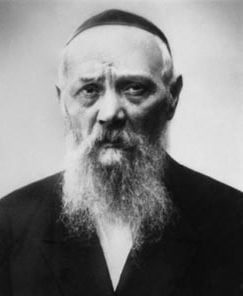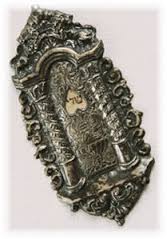This week we study the Torah portion of Eikev, which we will be reading this Shabbat in synagogues. This Torah portion contains the second section of the Shema, Vehayah im shamo’ah, where the commandment of mezuzah is given a second time. Traditionally, this is the week when we discuss mezuzah.
Coincidentally, tonight, the twentieth day of Av, is the yahrzeit of Rabbi Levi Yitzchak Schneerson, a prominent Kabbalist and the father of the Lubavitcher Rebbe, Menachem Mendel Schneerson.[1] Rabbi Levi Yitzchak has an interesting short commentary on the word mezuzah. In honor of his yahrzeit, I would like to expound upon and expand his commentary.
The sages of the Talmud say that forty days before a fetus is formed, it is announced in heaven that this child is going to be married to so-and-so.[2] Rabbi Levi Yitzchak says that the word mezuzah hints at this. The word mezuzah can be broken up as follows: Me-ZU-ZaH. The first letter, the letter “mem,” has a numerical value of forty. The word zu means “she” and zeh means “him” (literally, both zu and zeh mean “that,” however, zu has feminine gender and zeh has masculine gender, which allows interpreting these words as referring to “her” and “him” respectively). Thus the word mezuzah (which literally means a doorpost) hints at the Talmudic statement that forty (mem) days before a fetus is formed, she (zu) is going to be married to him (zeh). (Likutei Levi Yitzchak, Shemot-Devarim, p.453.)

The question is, What motivated Rabbi Levi Yitzchak to interpret the letter mem as implying forty days? Granted, the gematria of mem is forty, but what does that have to do with time? The reasoning, however, is not difficult to understand. In the Torah, the number forty is often used for time periods comprising forty units of time—forty days or forty years. Perhaps the most famous example is that Moses spent three consecutive periods of forty days and forty nights on Mount Sinai. The first time, he went up on the seventh day of Sivan, after G‑d gave the Torah to the Jewish people, to learn the Torah from G‑d, and he came down on the seventeenth day of Tammuz, when he was told that his people were worshiping the Golden Calf and broke the tablets, as it says, “And it came to pass at the end of forty days and forty nights, that the Lord gave me the two tables of stone, even the tables of the covenant” (Deuteronomy 9:11). The second time, Moses went up on the eighteenth day of Tammuz to beg forgiveness for his people’s sin of worshipping the Golden Calf and came down without G‑d’s atonement on the twenty-ninth day of Av, as it says, “So I fell down before the Lord the forty days and forty nights that I fell down; because the Lord had said He would destroy you” (Deuteronomy 9:25). The third time, he went up on the first day of Elul and came down on the tenth day of Tishrei, the first Yom Kippur, with the second tablets this time having obtained G‑d’s atonement, as it says, “Now I stayed in the mount, as at the first time, forty days and forty nights; and the Lord hearkened unto me that time also; the Lord would not destroy thee” (Deuteronomy 10:10).
Other biblical examples of the use of forty days or forty years include:
Rain fell for forty days and forty nights during the Flood, as it says:
…and I will cause it to rain upon the earth forty days and forty nights.”
(Genesis 7:4)
Noah waited for forty days after the tops of mountains were seen after the Flood, before releasing a raven, as it says:
And it came to pass at the end of forty days, that Noah opened the window of the ark which he had made.”
(Genesis 8:6)
Spies were sent by Moses to explore the land of Canaan (promised to the children of Israel) for “forty days,” as it says:
And they returned from spying out the land at the end of forty days.”
(Numbers 13:25)
Jews wondered for forty years in the desert waiting for the new generation to grow up, as it says:
And your children shall be wanderers in the wilderness forty years, and shall bear your strayings, until your carcasses be consumed in the wilderness.”
(Numbers, 14:33)
And
And the Lord’s anger was kindled against Israel, and He made them wander to and fro in the wilderness forty years, until all the generation, that had done evil in the sight of the Lord, was consumed.”
(Numbers 32:13)
Jonah prophesized to the people of Nineveh:
Forty days more, and Nineveh shall be overthrown.”
(Jonah 3:4)
The prophet Elijah had to walk forty days and forty nights before arriving at Mount Horeb (Sinai), as it says:
And he arose, and did eat and drink, and went in the strength of that meal forty days and forty nights unto Horeb the mount of God.”
(I Kings 19:8)
Goliath challenged the Israelites twice a day for forty days before David defeated him, as it says:
And the Philistine drew near morning and evening, and presented himself forty days”
(I Samuel 17:16)
Several early Hebrew leaders and kings are said to have ruled for “forty years,” for example, Eli (1 Samuel 4:18), Saul (Acts 13:21), David (2 Samuel 5:4), and Solomon (1 Kings 11:42).
Furthermore, in Kabbalah, we speak of four words each having ten sefirot. The process of progression and development of these words involves forty sefirot (ten for each of the four words). Consequently, the number forty signifies a complete transition or complete development, as in forty weeks of pregnancy. Thus, it is no wonder that Rabbi Levi Yitzchak interpreted forty (as denoted by the first letter of mezuzah—mem) as the number of days.
Now, I would like to use the logic of Rabbi Levi Yitzchak’s explanation to suggest two more meanings hidden in the word mezuzah.
First, when a woman becomes pregnant, the parents do not know the sex of the child she carries in her womb. (While it is possible today to discover the gender of the child using a sonogram, this technology wasn’t available until relatively recently and is not a natural way to discover the sex of the child, so we are going to disregard it.) Naturally, the sex of the child becomes apparent only after birth. That is why the pregnancy is called alma d’iskasyah, that is, the hidden world, during which the sex of the child is unknown, whereas the state after giving birth is called alma d’isgalyah, that is, the revealed world, where the sex of the child is revealed. The Talmud states that the typical pregnancy lasts approximately forty weeks (which roughly matches contemporary observations).[3] Thus, we can say that the word mezuzah hints at this by saying, Wait forty (mem) weeks to discover whether the child is a she (zu) or a he (zeh).
Second, the sages of the Talmud also state that when the woman becomes pregnant, her husband can pray for the gender of the child for forty days. According to a Beraita (see Berachot 60a), a father can pray for the sex of his child for the first forty days into the pregnancy, after which the gender is fixed, and the prayer would be in vain. My wife, Leah, in her insightful article “On the Embryological Foresight of the Talmud” (B’Oh HaTorah 19, (2009), pp. 19-24), demonstrated that this statement of the Talmud comports with modern embryology.[4] The word mezuzah can also be used as a mnemonic for this Talmudic prediction: for the first forty (mem) days, you can pray for the embryo to develop as a she (zu) or a he (zah).
We see from these three interpretations of the word mezuzah that the number forty plays an important role in the development of the embryo in utero. Why is this so? First, we note that the Hebrew word v’lad, which means a “fetus” or a “child,”[5] has a numerical value of forty. In Kabbalah, the letter מ (mem) represents the womb, because of its shape—an almost completely enclosed container with a small opening at the bottom.[6] The letter mem (forty) plus a kolel (“unit,” numerically one) for the whole word[7] gives forty-one, which is the numerical value of the word em, “mother.” In Pirke Avot (The Ethics of the Fathers) we find an expression, arbayim lebina, that means that at age forty, one achieves binah (“wisdom”).[8] In Kabbalah, binah is the partzuf Imah Ila, the Supernal Mother.
In Kabbalah, binah represents the future (whereas chokhmah represents the past, and da’at represents the present). From the statement in the Ethics of the Fathers, we can deduce that the number forty (which is associated with binah) hints at the future. Perhaps this is why in all these verses, forty days denote the anticipation of an important event. Similarly, we can say that one can pray for the gender of the child for forty days, in anticipation of having a boy or a girl, as one desires.
These two additional homiletical interpretations of the word mezuzah seem to be in line with the original interpretation by Rabbi Levi Yitzchak.
Endnotes:
[1] See my essay about Reb Levik “The Question You Promised to Ask,” at https://www.chabad.org/therebbe/article_cdo/aid/2673350/jewish/The-Question-You-Promised-to-Ask.htm.
[2] Talmud, Sotah 2a.
[3] Talmud, Niddah, 38a. There Shmuel (Amora, a second-century Babylonian physician and rabbi) says that a woman becomes pregnant and gives birth after 271 days, which is a full nine months, or after 272 or 273 days. In 2013 a study funded by the National Institutes of Health calculated the length of pregnancy beginning at ovulation or conception and found that the median time from ovulation to birth was 38 weeks and 2 days, or 268 days—just three days shorter than Shmuel’s estimate.
[4] See online at https://quantumtorah.com/wp-content/uploads/2020/12/On-the-Embryological-Foresight-of-the-Talmud.pdf. See sources there.
[5] See Genesis 11:30.
[6] This is one of the homiletic explanations for the requirement that a kosher mikvah had forty se’ah of water—the number forty is denoted by mem, which in turn represents the womb. The immersion in a mikvah is seen as a regression into a womb, after which one emerges as newly born, free from sin and spiritual impurities.
[7] This method of adding one to account for the whole word is frequently used in the Jewish numerology, gematria.
[8] Pirkei Avot (Ethics of the Fathers) (5:21).
